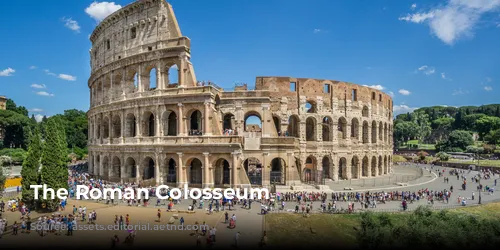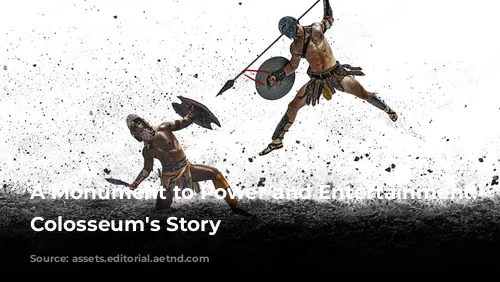The Colosseum, a majestic stone amphitheater, stands as a testament to the grandeur and extravagance of ancient Rome. Located just east of the Roman Forum, this colossal structure was a gift to the Roman people from Emperor Vespasian of the Flavian dynasty. Commissioned around A.D. 70-72, its construction marked a period of rebuilding and restoration following the turbulent reign of Nero.

From Chaos to Colosseum: Vespasian’s Vision
The Roman Empire had endured a chaotic period after Nero’s tragic death in A.D. 68. A series of civil wars followed, with four different emperors vying for the throne in just one year. Vespasian, the fourth emperor, eventually brought stability and began to restore the empire’s image. He sought to reverse the excesses of his predecessor and promote public welfare.
Vespasian seized the opportunity to reclaim a vast piece of land near the city center, once occupied by Nero’s opulent palace, the Golden Palace. This site, chosen for its central location, was deemed perfect for a new amphitheater. Here, the public could enjoy spectacles like gladiatorial combats, a favorite form of entertainment in ancient Rome.

The Colosseum Takes Shape: A Decade of Construction
The construction of the Colosseum, while ambitious, was remarkably swift. After nearly a decade of tireless labor, the structure was finally completed in A.D. 80, ready for its grand unveiling. Titus, Vespasian’s son and successor, officially dedicated the Colosseum with a spectacular 100-day festival.
This festival showcased the Colosseum’s true potential as a venue for public entertainment, featuring gladiatorial contests, wild animal hunts, and other grand displays. The completion of the Colosseum fell during Titus’ reign, a period marked by his compassionate leadership and successful recovery efforts after the devastating eruption of Mount Vesuvius.
The Colosseum: An Architectural Masterpiece
Standing at an impressive 620 by 513 feet (190 by 155 meters), the Colosseum was the largest amphitheater in the Roman world. Unlike earlier amphitheaters, which were often built into hillsides for support, the Colosseum was a freestanding structure, constructed using stone and concrete.
Its distinct exterior features three tiers of arched entrances, totaling around 80, supported by semi-circular columns. Each tier boasts a different architectural style, showcasing the Roman mastery of design: the bottom tier features the simple Doric order, followed by the elegant Ionic order, and finally the ornate Corinthian order at the top.
A World of Entertainment: The Colosseum’s Interior
The Colosseum boasted a seating capacity of over 50,000 spectators, likely arranged according to social standing. Awnings could be unfurled from the top tier, providing shade from the scorching Roman sun as the crowd watched gladiatorial combat, animal hunts, and even mock naval battles, where the arena was said to be flooded with water.
The majority of the combatants were enslaved people, condemned criminals, or prisoners of war. These individuals, often forced into combat for the entertainment of the masses, represent a somber side of the Colosseum’s history.
The Colosseum’s Decline: From Glory to Neglect
After nearly four centuries of hosting spectacular events, the Colosseum’s reign as a venue for entertainment came to an end. The decline of the Western Roman Empire and a shift in public tastes led to a gradual cessation of gladiatorial combat and other public spectacles by the 6th century A.D.
The Colosseum, now abandoned, became a source of building materials, with its stones being used for various projects, including cathedrals, palaces, and fortifications. The arena’s grandeur slowly crumbled, ravaged by weather, earthquakes, and neglect.
Redefining its Purpose: The Colosseum’s Rebirth
Despite its decline, the Colosseum remained a symbol of Rome’s rich history. In the 18th century, popes sought to preserve the arena as a sacred Christian site. However, the link between the Colosseum and early Christian martyrs remains uncertain.
By the 20th century, the Colosseum was a shell of its former glory, with nearly two-thirds of its original structure destroyed. Restoration efforts began in the 1990s and continue today, ensuring the Colosseum’s survival as a popular tourist destination and a testament to Rome’s enduring legacy.
The Colosseum, a monument to power and entertainment, stands as a reminder of a bygone era. Its vast scale and intricate design continue to inspire awe, while its history offers a glimpse into the lives of those who lived, fought, and entertained within its walls.
